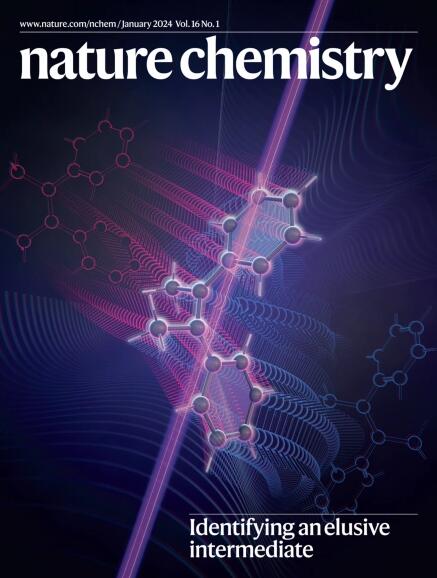Unravelling non-adiabatic pathways in the mutual neutralization of hydronium and hydroxide
IF 19.2
1区 化学
Q1 CHEMISTRY, MULTIDISCIPLINARY
引用次数: 0
Abstract
The mutual neutralization of hydronium and hydroxide ions is a fundamental chemical reaction. Yet, there is very limited direct experimental evidence about its intrinsically non-adiabatic mechanism. Chemistry textbooks describe the products of mutual neutralization in bulk water as two water molecules; however, this reaction has been suggested as a possible mechanism for the recently reported spontaneous formation of OH radicals at the surface of water microdroplets. Here, following three-dimensional-imaging of the coincident neutral products of reactions of isolated D3O+ and OD−, we can reveal the non-adiabatic pathways for OD radical formation. Two competing pathways lead to distinct D2O + OD + D and 2OD + D2 product channels, while the proton-transfer mechanism is substantially suppressed due to a kinetic isotope effect. Analysis of the three-body momentum correlations revealed that the D2O + OD + D channel is formed by electron transfer at a short distance of ~4 Å with the formation of the intermediate unstable neutral D3O ground state, while 2OD + D2 products are obtained following electron transfer at a distance of ~10 Å via an excited state of the neutral D3O. The mutual neutralization of hydronium and hydroxide ions is a reaction of fundamental interest that has recently been implicated in the generation of high concentrations of hydroxyl radicals at the surface of water microdroplets. Using three-dimensional imaging of the coincident neutral products of the reaction of D3O+ and OD−, two competing pathways for OH radical formation have now been experimentally observed.


氢离子和氢氧根离子的相互中和是一种基本的化学反应。然而,关于其本质上的非绝热机制的直接实验证据却非常有限。化学教科书将散水中相互中和的产物描述为两个水分子;然而,最近报道的在水微滴表面自发形成羟基自由基的过程中,这种反应被认为是一种可能的机理。在这里,通过对分离的 D3O+ 和 OD- 反应的重合中性产物进行三维成像,我们可以揭示 OD 自由基形成的非绝热途径。两种相互竞争的途径导致了截然不同的 D2O + OD + D 和 2OD + D2 产物通道,而质子转移机制则由于动力学同位素效应而被大大抑制。对三体动量相关性的分析表明,D2O + OD + D 通道是在 ~4 Å 的短距离内通过电子转移与中间不稳定的中性 D3O 基态形成的,而 2OD + D2 产物则是在 ~10 Å 的距离内通过中性 D3O 的激发态进行电子转移后得到的。
本文章由计算机程序翻译,如有差异,请以英文原文为准。
求助全文
约1分钟内获得全文
求助全文
来源期刊

Nature chemistry
化学-化学综合
CiteScore
29.60
自引率
1.40%
发文量
226
审稿时长
1.7 months
期刊介绍:
Nature Chemistry is a monthly journal that publishes groundbreaking and significant research in all areas of chemistry. It covers traditional subjects such as analytical, inorganic, organic, and physical chemistry, as well as a wide range of other topics including catalysis, computational and theoretical chemistry, and environmental chemistry.
The journal also features interdisciplinary research at the interface of chemistry with biology, materials science, nanotechnology, and physics. Manuscripts detailing such multidisciplinary work are encouraged, as long as the central theme pertains to chemistry.
Aside from primary research, Nature Chemistry publishes review articles, news and views, research highlights from other journals, commentaries, book reviews, correspondence, and analysis of the broader chemical landscape. It also addresses crucial issues related to education, funding, policy, intellectual property, and the societal impact of chemistry.
Nature Chemistry is dedicated to ensuring the highest standards of original research through a fair and rigorous review process. It offers authors maximum visibility for their papers, access to a broad readership, exceptional copy editing and production standards, rapid publication, and independence from academic societies and other vested interests.
Overall, Nature Chemistry aims to be the authoritative voice of the global chemical community.
 求助内容:
求助内容: 应助结果提醒方式:
应助结果提醒方式:


